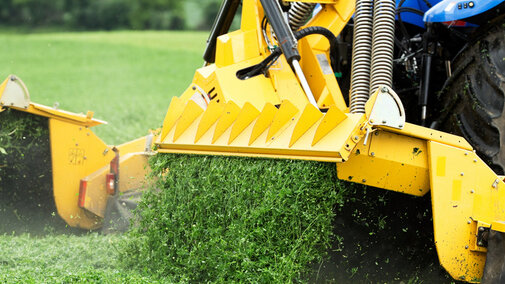Livestock Water on Pasture
As late spring and summer temperatures begin to heat up and cattle are on pasture, it’s important to make sure there is adequate water for livestock. How much do cattle need and where should it come from?
The water requirements for cattle depends on their size, class and environmental conditions. High humidity and greater temperatures also increase water demand. A University of Georgia study lists water requirements for days when the daily high temperature is 90°F. With these conditions, growing or lactating animals need two gallons of water per 100 pounds of body weight. This means a 1,400-pound lactating cow will need close to 28 gallons of water daily with 90°F daily highs. If the calves are 250 pounds, they will need about five gallons. Again, some of the water will come from grazed forage. Make sure water tanks or water points are accessible for smaller calves.
Having fresh, clean water should also be a priority. Whenever dry conditions occur or especially in later summer, water quality from water sources such as dugouts or ponds and dams may not be ideal. The ability to have water close by should also be a goal, although sometimes it’s simply not possible. More water locations can help meet the water demand but could also help grazing distribution too. Cattle will receive some of their daily water requirements when they are consuming high moisture feedstuffs such as fresh forage when grazing pasture, silages or green chopped feeds. Feeds that are high-energy increase the water requirement.
Keep an eye on water this summer and make sure livestock have enough, good quality water available.
Pasture Weed Management After Drought
Pasture grass root injury caused by drought and/or wildfire can extend into the next grazing season. If grass stands have only been slightly damaged, then recovery can be quick, especially with proper weed control, fertility and deferred grazing management. However, if the stressed pastures were overgrazing, then recovery may extend beyond one growing season and require patience. Further, root injury and biomass reductions are usually more prominent on sandy soil pastures than heavier soils.
During pasture recovery, higher invasive weed numbers are usually a symptom of previous grass stress, so herbicide spraying may provide short-term benefits. The downside of herbicide applications are spraying expenses and potentially damaging non-target desirable pasture plants.
Therefore, rather than just focusing on stress symptoms such controlling invasive weeds, consider increasing pasture rest periods for grass recovery. This may mean implementing rotational grazing with periods of no grazing in each pasture during the growing season. Also, installing more cross-fences to limit grazing in target zones can aid pasture rest and recovery.
For example, a three-pastures rotation system may lengthen rest days between grazing before the cattle rotate to the next pasture. When the grass is rapidly growing, cattle may move quicker such as every 30 days through the pasture rotation. Then, as grass growth slows or drought stress occurs, grazing time in each pasture may be lengthened to 45 days. Then, pasture rotation will have more days of rest prior between grazing periods.
To further reduce the negative impacts of grazing, alternate the first pasture in the rotation at the beginning of each growing season. This will allow each pasture to be grazed annually at different times of year compared to the previous year or two.
More online Nebraska Extension grazing strategies are available on UNL Beef and CropWatch.
Checking In on Alfalfa
It's time for the first cutting of alfalfa, and as you're out in the fields, it's a prime opportunity to spot any issues and plan corrective actions. But what should you be looking for?
First, check the color of your alfalfa. A uniform green is ideal. Dark green may indicate water stress, while yellow, purple, blue-green or red hues, interveinal chlorosis, misshapen leaves or patchy growth could signal nutrient deficiencies. While some issues are hard to fix mid-season, adjusting micronutrients like boron and sulfur can boost yields, especially in low organic matter soils. Confirm any deficiencies with soil or tissue samples.
Keep an eye out for diseases and insect pressure. If you see something unusual, step out and inspect the plants or use a sweep net — or even your ball cap — to catch pests. Make sure to clean it before putting it back on!
Watch for thinning areas in your stand. If interseeding alfalfa isn’t an option due to autotoxicity, consider warm-season annuals like teff for a summer yield boost while maintaining hay quality. For longer-term solutions, interseed with perennial forage grasses like orchardgrass during cooler months.
Finally, be vigilant for weedy patches. Problem plants like Canada thistle should be avoided or flagged for separate handling to control their spread. Note other weeds for future scouting and control.
Harvest time is perfect for field assessment. Look for standout spots and monitor for fertility issues, insects, weeds, and diseases. If stands are lacking, interseeding with annuals or perennials can help keep your productivity high.

